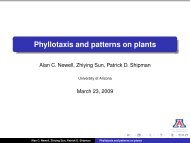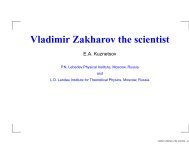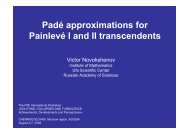High-temperature nonlinear phenomena in LNB crystals
High-temperature nonlinear phenomena in LNB crystals
High-temperature nonlinear phenomena in LNB crystals
You also want an ePaper? Increase the reach of your titles
YUMPU automatically turns print PDFs into web optimized ePapers that Google loves.
Dedicated to jubilee of<br />
Vladimir Zakharov<br />
<strong>High</strong>-<strong>temperature</strong> <strong>nonl<strong>in</strong>ear</strong><br />
<strong>phenomena</strong> <strong>in</strong> <strong>LNB</strong> <strong>crystals</strong><br />
Boris Sturman<br />
Institute of Automation and Electrometrey,<br />
Novosibirsk, Russia<br />
In collaboration with the University of Bonn, Germany
Physical background: Nonl<strong>in</strong>ear optical material<br />
LiNbO 3 <strong>crystals</strong> – Silicon of optics? Why?<br />
É Cheap and robust ferroelectric, T c ª 1200°C,<br />
C 3v symmetry<br />
É Transparent <strong>in</strong> the visible-to-<strong>in</strong>frared range (ª 4 eV forbidden gap)<br />
É<br />
<strong>High</strong> c (2) <strong>nonl<strong>in</strong>ear</strong>ity, large electro-optic coefficients<br />
É Doma<strong>in</strong> eng<strong>in</strong>eer<strong>in</strong>g: PPLN structur<strong>in</strong>g, photonic <strong>crystals</strong>,<br />
quasi-phase-match<strong>in</strong>g, etc<br />
É Sensitization by dop<strong>in</strong>g (Fe, Cu,...). Light-<strong>in</strong>duced charge transport<br />
É Generation of large electric fields and refractive <strong>in</strong>dex changes<br />
(reversible optical record<strong>in</strong>g)<br />
Serious drawback: Optical damage<br />
Unwanted generation of strong <strong>nonl<strong>in</strong>ear</strong> <strong>in</strong>dex changes<br />
and deterioration of light beams for I > (10 3 - 10 4 ) W/cm 2
A closer look at light-<strong>in</strong>duced charge transport<br />
j<br />
e<br />
=<br />
−β<br />
I<br />
+<br />
e µ n<br />
e<br />
e<br />
E<br />
+<br />
eD<br />
e<br />
∂n<br />
∂z<br />
e<br />
hw<br />
m e<br />
τ e<br />
CB<br />
ne<br />
N e<br />
α =<br />
N<br />
e<br />
σ<br />
e<br />
Neσ<br />
e<br />
I<br />
ne<br />
=<br />
hω<br />
Neσ<br />
e<br />
β = e<br />
hω<br />
µ<br />
eT<br />
De<br />
=<br />
e<br />
τ<br />
l<br />
e<br />
pv<br />
Light absorption coefficient<br />
Free electron concentration<br />
Photovoltaic coefficient<br />
E<strong>in</strong>ste<strong>in</strong> relation<br />
Fe 2+ Fe 3+<br />
n e<br />
Why high <strong>temperature</strong>?<br />
An ultimate goal of electron eng<strong>in</strong>eer<strong>in</strong>g:<br />
To remove photo-excitable electrons<br />
far below the background level, N e 200 °C , ions (H + , Li + , …) become mobile: j i<br />
= e m i<br />
(T) N i<br />
E<br />
In the electric equilibrium j S<br />
= j e<br />
+ j i<br />
= 0, but j e<br />
π 0<br />
The electron removal persists<br />
In other words, ions compensate the removed electrons and<br />
ma<strong>in</strong>ta<strong>in</strong> the charge quasi-neutrality
A trivial example<br />
Steady state<br />
+<br />
+<br />
+<br />
+<br />
<strong>LNB</strong><br />
-<br />
-<br />
-<br />
-<br />
j<br />
j i e<br />
1+<br />
σ<br />
e<br />
/ σ<br />
i<br />
σ<br />
eσ<br />
i<br />
| je,<br />
i<br />
| = E<br />
pv<br />
j<br />
e<br />
E<br />
+<br />
=<br />
j<br />
i<br />
= −<br />
E<br />
e<br />
pv<br />
j<br />
pv<br />
σ + σ<br />
+ ( σ<br />
i<br />
e<br />
+ σ ) E<br />
i<br />
=<br />
0<br />
There are permanent fluxes of electrons and ions to the right
Ultra-slow shock wave of electron density<br />
(PRL 2008)<br />
First experiments:<br />
U<br />
± - 0<br />
± +<br />
<strong>LNB</strong>:Fe, N e0<br />
~ 10 19 cm -3<br />
T = 600 °C, U 0<br />
= 1 kV<br />
t ~ 1 hour, w < 100 mm<br />
Nobody observed th<strong>in</strong>gs like this earlier
Model<br />
Assumptions and notation:<br />
N<br />
−<br />
+<br />
= N , N = N ( N +<br />
e<br />
i<br />
Li<br />
≈10<br />
cm<br />
20 −3<br />
)<br />
±<br />
j± = eµ ±<br />
N E, µ<br />
±<br />
∝ exp( −ε<br />
±<br />
/ T )<br />
z = z t),<br />
v = v(t)<br />
0<br />
0 (<br />
E = U l,<br />
ξ z / l<br />
0 0<br />
/ =<br />
0<br />
More predictions:<br />
Time dependence<br />
of the potential U l/2<br />
(t)<br />
Ma<strong>in</strong> predictions:<br />
v = µ E<br />
ξ =<br />
a<br />
t<br />
t<br />
0<br />
Σ<br />
=<br />
=<br />
=<br />
Ma<strong>in</strong> physical requirement:<br />
v = −µ<br />
−E 2<br />
/(1 +<br />
( −1+<br />
1+<br />
2at<br />
/ t )<br />
( ) (<br />
+ −<br />
µ / µ + 1 N / N −1)<br />
l<br />
t<br />
−<br />
0<br />
−<br />
0<br />
µ E<br />
−<br />
+<br />
0<br />
( 1+<br />
a / 2)<br />
aξ<br />
)<br />
0<br />
0<br />
a<br />
0
Comparison with experiment<br />
1: T = 650 °C, a = 7.4, t 0<br />
= 15 m<strong>in</strong><br />
2: T = 600 °C, a = 9.2, t 0<br />
= 35 m<strong>in</strong><br />
3: T = 550 °C, a = 9.8, t 0<br />
= 94 m<strong>in</strong><br />
No doubts rema<strong>in</strong>
Optical clean<strong>in</strong>g: How to remove electrons optically<br />
(NP-09)<br />
Initial set of equations<br />
b I(z)<br />
∂N<br />
∂t<br />
e<br />
+<br />
∂J<br />
∂z<br />
e<br />
=<br />
0,<br />
∂N<br />
∂t<br />
i<br />
+<br />
∂J<br />
i<br />
∂z<br />
=<br />
0<br />
J<br />
e<br />
= β I<br />
N<br />
e<br />
− µ n E<br />
e<br />
e<br />
− D<br />
e<br />
∂n<br />
e<br />
∂z<br />
J<br />
i<br />
= µ N E<br />
i<br />
i<br />
− D<br />
i<br />
∂N<br />
i<br />
∂z<br />
β I(z)<br />
The photovoltaic drift velocity<br />
∂E<br />
=<br />
∂z<br />
n<br />
e<br />
4π<br />
ε<br />
sNeIτ<br />
e<br />
=<br />
hω<br />
0 0<br />
( N − N − N + N )<br />
i<br />
e<br />
i<br />
e
Zero-model of optical clean<strong>in</strong>g<br />
σ<br />
I<br />
0<br />
e<br />
Results: Static light beam, v = 0<br />
Works, but takes a long time
Results: Mov<strong>in</strong>g light beams<br />
A different situation<br />
An exponential decrease/<strong>in</strong>crease<br />
at the divergence/convergence po<strong>in</strong>ts<br />
N<br />
e<br />
γ =<br />
0<br />
( ± z , t) / N = exp( ± γ t / t<br />
1<br />
2 (v / v<br />
0<br />
)<br />
e<br />
ln(v<br />
0<br />
/ v)<br />
0<br />
)<br />
Two zero (fixed) po<strong>in</strong>ts (±z 1<br />
)<br />
of the effective<br />
velocity profile u(z)
Concentration profiles for mov<strong>in</strong>g beams<br />
A v > v 0 scenario<br />
Abandon<strong>in</strong>g<br />
of the cleaned area<br />
An exponential clean<strong>in</strong>g,<br />
No profile breack<strong>in</strong>g
Beyond the zero-model:<br />
Impact of <strong>nonl<strong>in</strong>ear</strong> <strong>phenomena</strong><br />
Two parameters to control<br />
the <strong>nonl<strong>in</strong>ear</strong> behavior<br />
A small parameter<br />
to simplify theory<br />
a<br />
b<br />
=<br />
=<br />
≈10<br />
−3<br />
0 d<br />
0 0<br />
σ<br />
e<br />
/ σ<br />
i<br />
< 1<br />
0<br />
td<br />
= ε / 4π σ<br />
Σ<br />
0 0<br />
Ne<br />
/ Ni<br />
< 1<br />
t<br />
/ t<br />
Nonl<strong>in</strong>ear effects<br />
a = b = 0.01<br />
b = 0<br />
Break<strong>in</strong>g of<br />
the concentration profile<br />
Stabilization by electron<br />
diffusion<br />
Increase of N m<strong>in</strong><br />
Impairment of<br />
the clean<strong>in</strong>g performance
More <strong>nonl<strong>in</strong>ear</strong> effects<br />
b = 0<br />
Ç Shift of the discont<strong>in</strong>uity backwards<br />
Ç Separation of the beam from the cleaned area
More tricks<br />
An asymmetric<br />
flat-top I-profile<br />
This ensures:<br />
Ç Increas<strong>in</strong>g of the exponential decay rate g<br />
Ç Separation of the zero (fixed) po<strong>in</strong>ts<br />
Ç Flatten<strong>in</strong>g of the concentration peak<br />
Ç Suppression of the impact of <strong>nonl<strong>in</strong>ear</strong> effects
About experiment<br />
At least four variable experimental parameters, I 0 , z 0 , v, s i (T)<br />
Uncerta<strong>in</strong>ty of material parameters<br />
At least two different cases:<br />
Doped <strong>crystals</strong> (N e<br />
0<br />
> 10 16 cm -3 ). The profile N e<br />
(z) can be monitored<br />
Via absorption scan. The model parameters are known (measurable).<br />
Not useful to remove electrons up to (10 11 – 10 12 ) cm -3 , but useful to<br />
test the method<br />
Undoped <strong>crystals</strong> (optically transparent). The <strong>in</strong>itial concentration<br />
N e<br />
0<br />
< 10 15 cm -3 cannot be measured. Model parameters are uncerta<strong>in</strong>.<br />
Promis<strong>in</strong>g for applications<br />
Long-time treatments, t > 1 day, T = 180 °C, H + ions<br />
The clean<strong>in</strong>g performance is yet far from optimum
N e 0 ª 6 ¥ 10 16 cm -3 , N i 0 ª 2 ¥ 10 18 cm -3 ,<br />
z 0 ª 70 mm, l = 514 nm, I 0 = 10 W/cm 2 ,<br />
v = 0, a ª 0.5, b
Thank you!






